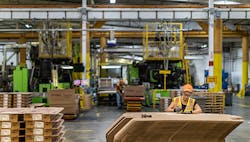Mark Duncan is OEM segment marketing manager at Schneider Electric.
What sorts of sensing technologies have improved the effectiveness and reliability of picking systems and conveyance systems?
Mark Duncan, OEM segment marketing manager, Schneider Electric: On conveyance systems, roller conveyors make up a large percentage of conveyors used for transportation of goods in a warehouse or distribution center. A common problem is that traditional sensors used for this application are exposed and therefore prone to misalignment or damage. New sensing technology is available that keeps sensors hidden and therefore protected, integrated within the conveyor rollers. Easily installed between conveyor rollers, these new sensors drop into the system with a simple click in seconds—no brackets or screws required.
Also read: Warehouses continue to improve efficiency with collaborative robots, AMRs and AGV technology
Once installed, the sensors cannot be hit by items on the conveyor or operators, which prevents misalignment or damage. The sensor has a detection range of up to 4 inches and includes special lenses and LED power to protect it from dust accumulation. Compatible with zone controllers from current motorized roller manufacturers or with standard programmable logic controller platforms, a variety of connectors or cable wires are offered.
With more mobile equipment in the warehouse, new lower-cost sensing technology on this equipment is needed for detection of a large coverage area, detection of obstacles even in harsh environments, and must be highly immune to electromagnetic interference.
New software-configurable wide beam ultrasonic sensors can solve many issues for this application where the width of the detection beam becomes much larger and can cover a greater area. When conditions require multiple sensors installed in close proximity to each other, the synchronization feature of the new ultrasonic sensors allows reliable detection of objects from each sensor with minimal risk of cross-talk.
In addition, new ultrasonic sensors come in an anti-UV plastic housing and can operate in temperatures ranging from -40 °C to +70 °C. These robust features, combined with their reliable, wide beam detection of obstacles, make them virtually the perfect sensor for mobile equipment.
These sensors are also E2-certified for mobile equipment. This entails a higher immunity to electromagnetic interference, even in the most demanding environments.
As warehouse distribution centers continue to grow larger, how are tracking and intelligence helping to keep up with customer demands?
Mark Duncan, OEM segment marketing manager, Schneider Electric: From our experience the main expectation is called end-to-end vision. The expectations about the future supply chain are not only efficiency and reliability, but flexibility to react. We have learned this lesson from the uncertainty of the past two years. Visibility along all of the supply chain, from the end of line up to the last mile of distribution, is requested, and the capability to react by rebalancing orders during the process to keep the shortest possible lead time is the primary objective.
To be able to propose end-to-end vision, technologies such as cloud connection, tracking and data collection associated with artificial intelligence are expected. We need to associate all these technologies with high-level automation systems to provide a tool that can propose all information to react with the right decision when events happen, in a system which has to manage the highest possible number of orders.
A second important topic is the energy management and the carbon footprint. Here again the connection of the energy management software to the end-to-end vision will assist in the decision process to help keep up with customer demands. Advanced software solutions with the ability to converge and contextualize engineering, operations, performance and financial data for end-to-end enterprise visibility will be needed.
New affordable radio-frequency identification (RFID) and inductive identification systems are making access control and traceability in the warehouse much easier.
RFID system frequencies range between 50 kHz and 2.5 GHz. The most widely used is 13.56 MHz.
The RFID system makes it possible to perform traceability, object identification or tracking, and access control functions. The information is stored in a memory that can be accessed using a simple radio frequency link. This memory is in the form of an electronic tag, which contains an antenna and an integrated circuit. Tags contain the information associated with the object to which it is fixed. When a tag enters the field generated by the reader/smart antenna, it detects the signal and exchanges the data—read or write—between its memory and the reader/smart antenna.
The applications are numerous:
- logistics—goods out, goods in, transit
- tracking and sorting of pallets and large parcels
- flexible traceability.
Traceability is used to identify the origin of a particular batch or unit load. It allows you to explore the stages that the product has gone through, from its processing to its final delivery, including the identification of raw materials used and the production operations carried out.
Which technologies have allowed warehouses to increase throughput rates while expanding product ranges and still maintaining accurate order fulfillment?
Mark Duncan, OEM segment marketing manager, Schneider Electric: Growth in ecommerce has escalated order volumes in the warehouse resulting in higher demand for automated solutions in fulfillment and distribution (Figure 1). From picking orders to singulating parcels from bulk flow, the act of selecting, orienting and placing individual items is one of the most common and labor-intensive tasks in warehouses (Figure 1).
For singulating and inducting parcels into a sortation system, there are several key technology enablers to create a productive, cost-effective robot induction system. These are the vision system, gripper, robot and system controller.
The need for a compact design and high-speed requirements dictate high-performance robotic technology. Solutions like the delta robotic technology meet the need that was identified as one of the fastest robot solutions.
A best-in-class compact footprint allows for easy retrofit of system into existing facilities and operations.
The system can be applied to multiple layouts driven by customer sites. Our standard layout is driven by the need to retrofit in sites with limited footprint, and these layouts are generally capable of 1,500 to 2,000 pph. In greenfield scenarios and with customers willing to overlook sunk costs, we can deploy parallel system architectures that can meet rate demands from 2,000 pph to 2,500 pph.
Because of the warehouse’s physical nature, how much of the facility’s hardware can be replaced with software in order to facilitate easier upgrades, expansions and reconfigurations?
Mark Duncan, OEM segment marketing manager, Schneider Electric: The customer expectation is now to obtain universal automation not linked in a proprietary system or automation vendor that requires dedicated facility hardware and field devices. Some years ago, this was a dream. But now, thanks to new software technology and the capability to bridge automation OT and IT systems, we can think to virtualize the PLC.
Figure 2: Universal automation could mean more labor-efficiency to engineer/operate and improve innovation.
The result is that we have a universal automation software running on a PC-based control system. The benefit is being a vendor-independent platform with portable application software and interoperable hardware.
Having such universal automation could be easy to interface with IT systems. It could become more labor-efficient to engineer/operate and improve innovation, as well as the evolution of installed base for easier upgrades, expansions and reconfigurations (Figure 2).
An additional next step would be to run this universal automation software alongside the IT system. We could envision running the virtual PLC in the local data center with other IT software. Of course, this solution must be shared across all the ecosystem OEMs, IT SI and IT software providers.
How have automated storage and retrieval systems' roles changed over the past 10 years?
Mark Duncan, OEM segment marketing manager, Schneider Electric: In warehouse applications where fulfillment is done, the storage and retrieval system is at the core of the operation, regardless of building space volume.
Increasing throughput rates and expanding product ranges result in the numbers of SKUs significantly impacting the storage systems. The challenge is to be as fast as possible and consume the least amount of space as possible in the building. To solve the problem, we see the high-density storage solution as an alternative.
Depending on the type of goods for storage, a lot of mechanical solutions, such as automated guided vehicles (AGVs), robotics, shuttles and crane stackers, can be used.
Those solutions have challenged the automation provider to open the platform for more software capability, to integrate vision and motion and add a more complex mathematical algorithm, as well as offer a better link with the IT system to be able to run artificial intelligence.
We are only at the beginning of this journey. The expectation is a system able to address all challenges in a fully automated way without any human workforce and in addition respecting new sustainability constraints.
We see that automated storage and retrieval systems have become more performant, but the driver of the evolution will come from more erratic consumer demands with sustainability concerns: be delivered immediately with no impact on planet.
Will autonomous mobile robots replace automated guided vehicles altogether, or is there room for both, based on the application or complementary functions?
Mark Duncan, OEM segment marketing manager, Schneider Electric: Both. The difference between an AGV and an AMR is mainly the capability of the AMR to make its own decision in front of an obstacle. The rapid adoption of AMRs is linked to the capability to get enough operational efficiency with different levels of complexity in the environment of autonomous vehicles.
Autonomous mobile robots find the most efficient route to achieve each task and are designed to work collaboratively with operators, such as picking and sortation operations, whereas AGVs typically do not.
Autonomous mobile robots make processes and workflows more efficient and productive. The advantage of such systems is that they are highly flexible for on-demand delivery to any location. They can handle failure without bringing down the entire manufacturing operation, since AGVs can plan paths around the failed device. They also are quick to install with less downtime for the factory.
Both are quite complementary in large warehouse facilities.
How will ANSI/RIA R15.08 affect robotic solutions in warehouse environments?
Mark Duncan, OEM segment marketing manager, Schneider Electric: The new ANSI/RIA R15.08-1-2020 (R15.08) standard for mobile robots provides updated and formalized definitions for AGVs, AMRs and other mobile robotics types. The revised definitions are critical for the proper application of R15.08 and, as such, it’s critical that both users and developers of industrial mobile robots take note.
Autonomous mobile robots are a rapidly growing segment of industrial automation that have lacked universally accepted definitions and their own safety standards. Consensus safety standards must be in place so that industry can be assured that industrial mobile robots are safe. In turn, these same standards assist technology vendors to ensure that the solutions they develop follow universally accepted best practices for safety.
The ANSI/RIA R15.08 standard has provided a clear definition between AGV and AMR. The fact that an AMR can decide to change the path used to move from Point A to Point B increases the level of risk of collision in the operation area.
Because of this difference, it’s mandatory to have a different risk management strategy between AMR and AGV. This will increase the complexity for creating a control system for an AMR.
We don’t think that will be a roadblock for AMR, and this will have less impact on the development of AMR than our capability to develop the intelligence necessary to make a decision in a complex environment.
Given the extraordinary percentage of manual operation in most distribution centers, will the 24/7 fully autonomous warehouse order-fulfillment center ever become commonplace?
Mark Duncan, OEM segment marketing manager, Schneider Electric: Perhaps. On one hand we can see fully automated micro fulfillment centers in inner city areas—automatic goods to person—close to being deployed on a large scale.
Figure 3: The U.S. economy is currently in a high-pressure labor market, and warehouses and distribution centers are feeling the pressure.
On the other hand, we have the large distribution centers that manage all types of goods, both regular and irregular, and are operating still with a lot of manual repetitive tasks. Considering that the manual repetitive work in a distribution center is not ideal for human labor, we can suggest that tomorrow all these supply-chain operations will be composed of an autonomous warehouse order-fulfillment center.
Fortunately, or unfortunately, depending on your perspective, logistics operations are very complex because of the huge diversity of goods within them.
The U.S. economy is currently in a high-pressure labor market, and warehouses and distribution centers (DCs) are feeling the pressure (Figure 3). From workers aging out of the workforce, complications from the pandemic, naturally high turnover rates and intense competition, DCs are in an endless battle for laborers, despite increasing wages. Adding to the labor problem is that 80% of DCs primarily operate with a manual workforce.
Robotics and automated solutions are key to supporting DCs’ higher production volumes and maximizing operational productivity.
However, the maturity of technology to generate a fully autonomous system running without human support is not yet completely ready. The cost and the return on investment of such a solution must be demonstrated. The new jobs generated for maintenance of such a system must be defined and realized.
Will autonomous warehouse order-fulfillment center ever become commonplace? Probably, yes. When that will happen is much more difficult to forecast.









